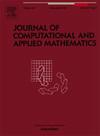为二阶(振荡)系统保留两个不变式的松弛 RKN 型积分器
IF 2.1
2区 数学
Q1 MATHEMATICS, APPLIED
Journal of Computational and Applied Mathematics
Pub Date : 2024-10-02
DOI:10.1016/j.cam.2024.116300
引用次数: 0
摘要
最近,松弛技术得到了广泛应用,它可以在保留原始方法全部精度的同时,实现不变式守恒。迄今为止,我们只考虑了系统的单一不变式。在本研究中,通过对松弛技术的温和推广,对 Runge-Kutta-Nyström (RKN) 积分器进行了修改,以保留二阶常微分方程(ODE)系统的两个不变式。所提出的积分器可以是显式的,并且具有任意高阶。松弛 RKN 积分器的精确性和有效松弛参数的存在已得到证明。新积分器的构造是在适应 RKN(ARKN)积分器的框架下进行的,该积分器是专门为数值求解二阶振荡系统而设计的。因此,所提出的积分器在精确积分均质振荡系统 q′′+Kq=0 的意义上可以保持振荡。本文章由计算机程序翻译,如有差异,请以英文原文为准。
Relaxation RKN-type integrators that preserve two invariants for second-order (oscillatory) systems
Recently, the relaxation technique has been widely used to impose conservation of invariants while retaining the full accuracy of the original method. So far, only a single invariant of a system has been considered. In this work, by a mild generalization of the relaxation technique, the Runge–Kutta–Nyström (RKN) integrators are modified to preserve two invariants for second-order system of Ordinary Differential Equations (ODEs). The proposed integrators can be explicit and of arbitrarily high order. The accuracy of the relaxation RKN integrators and the existence of valid relaxation parameters have been proved. The construction of the new integrators is under the framework of adapted RKN (ARKN) integrators which are specially designed for numerical solving second-order oscillatory systems. Therefore, the proposed integrators could be oscillation-preserving in the sense that they exactly integrate homogeneous oscillatory system . Some numerical experiments are conducted to show the advantage and efficiency of the proposed integrators in comparison with the standard (A)RKN integrators.
求助全文
通过发布文献求助,成功后即可免费获取论文全文。
去求助
来源期刊
CiteScore
5.40
自引率
4.20%
发文量
437
审稿时长
3.0 months
期刊介绍:
The Journal of Computational and Applied Mathematics publishes original papers of high scientific value in all areas of computational and applied mathematics. The main interest of the Journal is in papers that describe and analyze new computational techniques for solving scientific or engineering problems. Also the improved analysis, including the effectiveness and applicability, of existing methods and algorithms is of importance. The computational efficiency (e.g. the convergence, stability, accuracy, ...) should be proved and illustrated by nontrivial numerical examples. Papers describing only variants of existing methods, without adding significant new computational properties are not of interest.
The audience consists of: applied mathematicians, numerical analysts, computational scientists and engineers.

 求助内容:
求助内容: 应助结果提醒方式:
应助结果提醒方式:


